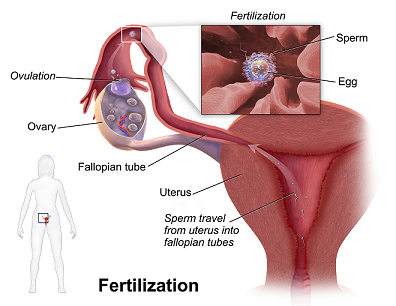The process of fertilization is a step-by-step process with the end result being a human life. It begins with a fertilized egg which will remain in the mother's womb until it is ready to be born. The egg and sperm join together in a combined effort of human fertilization to become a zygote, or fertilized egg. There are several steps between the process of fertilization and the birth of a life.
Where Does Fertilization Occur?

The Fallopian tubes is where most fertilization happens for normal pregnancies. When a man and a woman engage in intercourse the man ejaculates semen into the vagina of the woman. Up to 150 million sperm can be released in just one ejaculation of the man's semen. The sperm set off to meet the egg in the Fallopian tube but they have to get there quickly as they will die between 12 to 48 hours of ovulation.
It can occur in the upper portion of the uterus or it could even happen on the outside of the reproductive tract in the event of an inflammatory disease in the pelvic region. This would create an ectopic pregnancy which is a serious occurrence.
How Does Fertilization Occur?
The process as to "where human fertilization occurs" starts with a woman's menstrual cycle. This cycle gets the woman's body ready and about half way through human fertilizations begins. The egg reaches ovulation and is released into the Fallopian tube where fertilization will take place.
With only around 85% of sperm able to properly reach their travel destination, only 15% of the sperm that are ejaculated are able to make it all the way to the egg. The sperm follow the signals that are given by the cervix and the vagina and reach the opening of the uterus. They will then make their way through the mucus of the cervix and move up the uterus lining. The womb, or the uterus lining, is where you will find the baby growing after the egg has been fertilized.
Of the approximately 1,000 sperm that are left, they not only have to make their way to the uterus they also have to find the right Fallopian tube. While there are two to choose from, the egg can only be found in one of them. If the sperm select the right tube it will find the egg.
The entire process, from ejaculation to finding the egg, only takes around 20 minutes. The dozen or so sperm that are trying to make it to the egg begin to circle the egg in an effort to be the first one to fertilize the egg.
Watch a video demonstrating clearly how fertilization occurs:
Process of Conception
After know where does fertilization occur, here's more. It's very hard to pinpoint the exact day you will have gotten pregnant. The best your doctor can do is to begin counting the beginning of your pregnancy based on the first day you last had your period. That accounts for about 2 weeks before you will have actually conceived.
|
Process |
What Happens |
|
Ovulation |
As the eggs grow into follicles each month one escapes, usually a couple of weeks before your upcoming period. |
|
The hormones rise |
Once the egg is away from the follicle it becomes the corpus luteum which puts forth a hormone that gets the uterus ready for the egg with a thick lining. |
|
The egg moves on to Fallopian Tube |
The egg stays in the fallopian tube for around 24 hours as it waits for that one sperm to fertilize it. This occurs around 2 weeks from the time of your last period. |
|
What happens if egg doesn’t get fertilized |
If the egg doesn't become fertilized, it goes through the uterus and disintegrates. Hormones go back to normal, the uterus sheds its lining and you will begin your period. |
|
Fertilization |
If the egg becomes fertilized no other sperm is able to penetrate the egg. The genes of the baby are determined the moment the egg is fertilized. Sperm with a Y chromosome mean it's a boy and an X chromosome it's a girl. |
|
Moving over to the uterus |
While the egg remains in the fallopian tube for up to 4 days it starts to divide into cells just 24 hours once it has been fertilized. The main focus of the egg is to implant itself into the side of the uterus. After about 3 weeks the first nerve cells of the baby have been formed. |
|
Pregnancy hormones |
The hormone that registers on your pregnancy test is called hCG. It will take up to 4 weeks for this hormone to reach a high enough level that it can be spotted on the test strips. |
Now you know all about where does fertilization occur and how it occurs.






